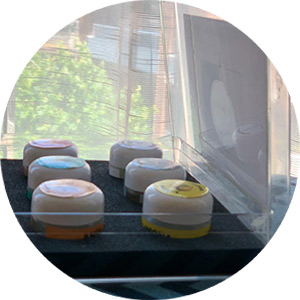29 May, 2020
Loss of smell and COVID-19: What we know, symptoms, diagnosis and treatment
As most people know by now, SARS-CoV-2 is a type of coronavirus that affects people and that is responsible for COVID-19. This disease is characterized by a series of breathing problems, mostly with mild symptoms (80% of cases). Sometimes these respiratory disease symptoms are accompanied by other conditions. Specifically, recent studies suggest that up to 88% of patients with COVID-19 present a loss of smell and taste. Most of these patients (80%) will regain their senses of smell and taste on teir own, over time. For those who do not regain their sense of smell either partially or at all, there is only one option available right now: olfactory training.
UPDATED INFORMATION – Current situation and advice to face the COVID-19 pandemic
RESPIRATORY DISEASE SYMPTOMS OF COVID-19 AND LOSS OF SMELL
Several COVID-19 symptoms are widely known already: fever, cough, pneumonia, respiratory distress, runny nose, nasal obstruction, breathing issues… Patients who show lung deterioration may even require admission to the ICU. But there is another symptom that has a significant impact on the patients’ quality of life, and that occurs in a large number of cases: the loss of their senses of smell and taste. They can occur independently or both at the same time, though the most severe is anosmia, the total loss of the sense of smell.
INCIDENCE OF smell loss IN PATIENTS WITH COVID-19
In our experience, we can state that the majority of COVID-19 patients lose both their smell and taste. 10% of the cases present hyposmia, the partial loss of smell, even before other general symptoms appear.
According to studies carried out in China, between 5 and 7% of COVID-19 patients presented a smell loss. However, the latest European multicentric studies show that the percentage of COVID-19 patients who have lost their senses of smell and / or taste – to a greater or lesser degree – is around 88%1
“The latest European multicentric studies show that around 88% of patients with COVID-19 have experienced a loss of their sense of smell”
Dr. Isam Alobid
1 J Investig Allergol Clin Immunol. 2020 May 14:0. doi: 10.18176/jiaci.0567. [Epub ahead of print]
Olfactory dysfunction in the COVID-19 outbreak.
Izquierdo-Dominguez A, Rojas-Lechuga MJ, Mullol J, Alobid I.
CAUSES OF LOSS OF THE SENSE OF SMELL, OR ANOSMIA
The loss of smell, or anosmia, is not solely caused by COVID-19 but may have different origins. The most frequent causes of the smell loss are viral infections of the upper respiratory system: common cold, sinusitis, bronchitis, etc. Another common cause of anosmia is the chronic inflammation of the nose and paranasal sinuses: allergic rhinitis, chronic rhino-sinusitis,… Finally, the last cause of smell loss is traumatic brain injury, which causes significant damage to the neuroepithelium and to the olfactory bulb.
DEGREES OF LOSS OF THE SENSE OF SMELL
Smell loss can be graded depending on its severity. The scale to measure it goes from 0 to 10. From 0 to 3 it is considered a slight loss of smell; from 3 to 7, moderate; and from 7 to 10, it is a severe loss of the sense of smell.
The mild or moderate alterations of the sense of smell (from 0 to 7) are known as hyposmia. A severe or total loss of the sense of smell (from 7 to 10) is known as anosmia.
“COVID-19 patients present a severe loss of the sense of smell, or anosmia”
Dr. Isam Alobid
RECOVERY FROM A COVID-19 SMELL LOSS
1 in 5 COVID-19 patients regained their sense of smell within a week after the appearance of the symptoms of the disease. A third group regained it in one to two weeks. Finally, 1 in 5 regained their sense of smell after two to four weeks after COVID-19.
The majority of patients (80%) who have lost their sense of smell due to COVID-19 regained it within a maximum of one month. However, they still present a slight reduction of their sense of smell, or hyposmia. This type of smell loss is called “long-term.” At the moment, we have no information on the evolution of long-term smell loss further down the line. These patients need to be followed up to check their evolution of smell loss, and to know if the designated treatments are being effective.
“The majority of patients (80%) who have lost their sense of smell due to COVID-19 regained it within a maximum of one month. However, they still present a slight hyposmia”
Dr. Isam Alobid
IS THERE A TREATMENT FOR COVID-19 RELATED SMELL LOSS?
As of now, we do not have any medical treatment for COVID-19 related smell loss. We are only dealing with its natural healing process over time. That said, our experience with post-viral anosmia gives us tools that can help these patients regain their olfactory capacity.
Literature is widely heterogeneous regarding loss of smell; we advise home isolation measures and/or social distancing, and to carry out diagnostic tests for SARS-CoV-2 when possible in patients with sudden/severe loss of smell who cannot be promptly evaluated #anosmia #COVID19 pic.twitter.com/U7JvuxWst2
— Isam Alobid (@IsamAlobid) May 15, 2020
DIAGNOSIS OF THE LOSS OF THE SENSE OF SMELL AFTER COVID-19
Patients who lost their sense of smell with COVID-19 should undergo an olfactometry test to quantify their smell loss and to check their remaining smell perception. Olfactometry tests measure a person’s olfactory capacity and, therefore, any loss of the sense of smell. It consists of a test in which patients must detect, identify and remember a series of scents. These answers are then compared to the national average in order to establish a score, which defines their level of hyposmia (mild, moderate, severe) or anosmia.
At present, olfactometry tests cannot be performed by COVID-19 patients in the acute phase of infection. On one hand, this is due to the risk of scent contamination; on the other, the risk of disease transmission needs to be taken into account. This is why we must exercise patience and see how these patients progress before approving the only type of treatment that currently exists: olfactory training.
HAVE YOU PASSED THE COVID-19 AND HAVE NOT RECOVERED THE SMELL? OUR TEAM OF EXPERTS CAN HELP YOU
WHAT DOES OLFACTORY TRAINING CONSIST OF?
Olfactory training consists of a series of exercises which allow patients who have suffered from smell loss to learn how to recognize scents again. Distinguishable scents are selected and matched to their corresponding images to help patients train their noses and their olfactory memory. This training revolves around the brain’s ability to identify, store and remember smells, relating them to the senses of sight and hearing. For example, a perfumer, a winemaker, or a beer taster has a capacity to recognize and remember scents that is much higher than average. This is, above all, because they have a highly trained sense of smell. The principle is the same.
Olfactory training should be performed twice a day (morning and afternoon) for at least three months. After this time, a new olfactometry test is performed to grade the benefits resulted from this training. Patients who haven’t yet regained their sense of smell may continue with the training.
“In our experience with post-viral anosmia, one in three anosmic patients regain their sense of smell after a six-month olfactory training”
Dr. Isam Alobid
WHAT SHOULD I DO IF I HAVE LOST MY SENSES OF SMELL AND TASTE?
If you’ve had COVID-19 and you have suffered a loss of smell and taste, the first thing you should do is wait until you’ve recovered from the disease. If you have recovered from COVID-19 but your sense of smell has not yet returned, you should book a visit and undergo an in-depth examination. In this case, you’ll undergo a nasal endoscopy to ensure that there are no endonasal alterations associated with the smell loss. Once this is ruled out, an olfactory bulb scan will be performed to check any bulb atrophy. An olfactometry test will follow. At barnaclínic + we have an olfactometry test comprised of 8 scents, which gives us a clear picture of the patient’s olfactory capacity and helps us offer the appropriate treatment for each case.
Having ruled out endonasal lesions and with the result of these tests at hand, olfactory training can begin.

Example of a commercial kit for olfactory training
There are a number of olfactory training kits on the market which can be purchased at most pharmacies. With these kits, containing six scents in an airtight box, you can start your home training. As mentioned earlier on, olfactory training must be carried out for three months. After this period, another olfactometry test will be done. Depending on the result, a rhinology expert will advise you on whether it would be best to continue with the training.
We are developing a Smartphone application for a day-by-day follow up of those patients who have suffered a smell loss and who are currently undergoing training. With this app we can monitor patients, tell them how to proceed in their training and give them the best advice throughout their olfactory training.







